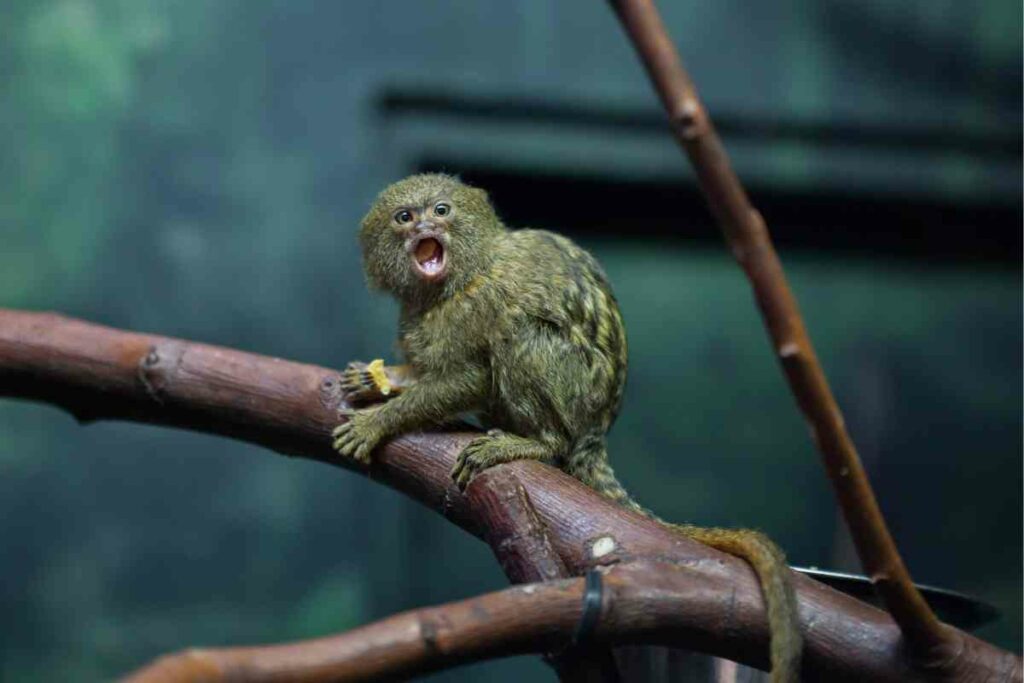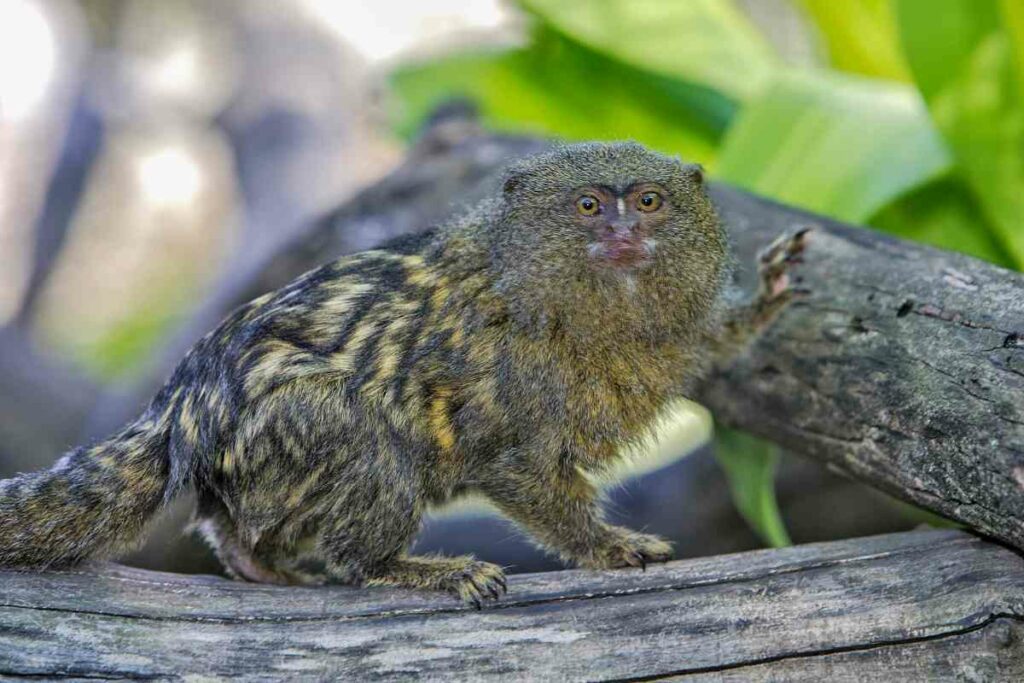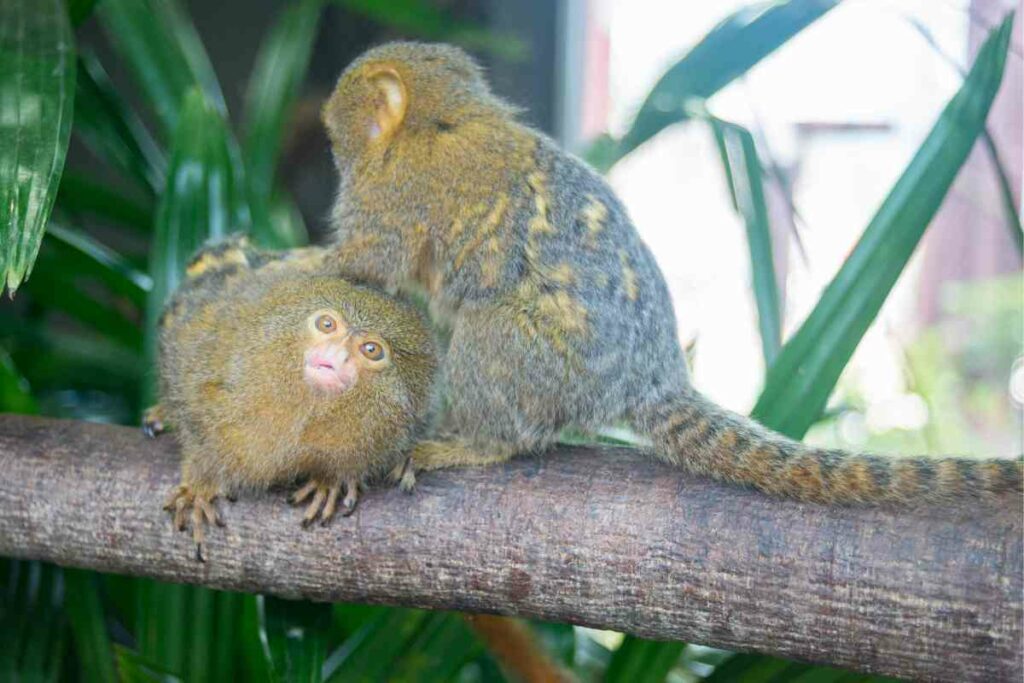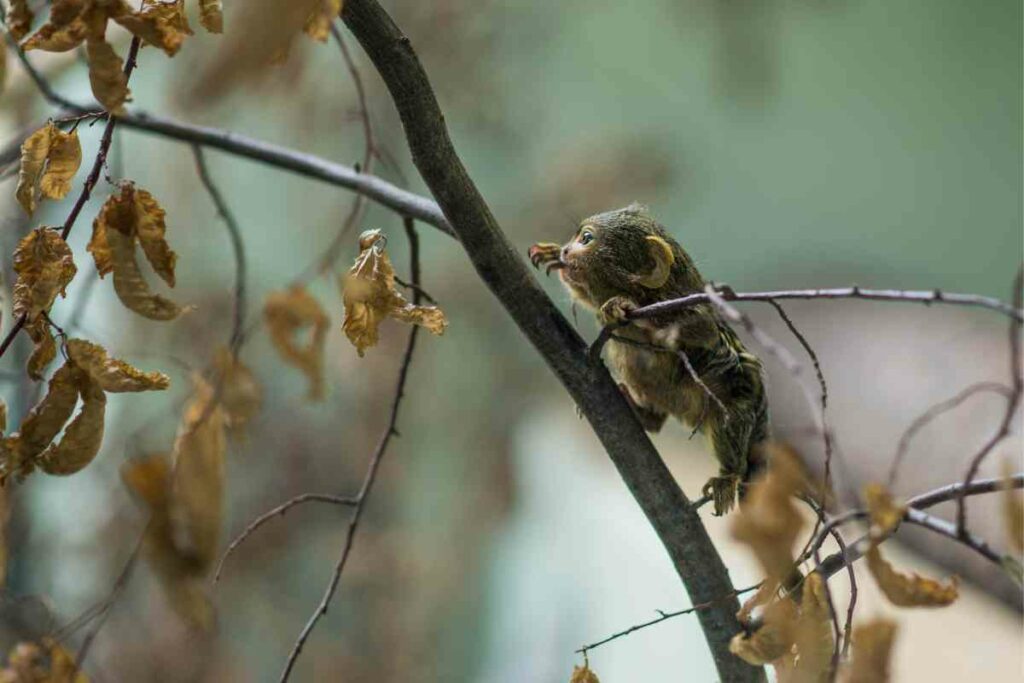Human beings are naturally curious about unusual animals.
Whether it’s a furry ball of feathers or a gigantic sea animal, exotic creatures receive more attention than ordinary ones.
One such sensational species is Finger Monkeys.
Besides their fascinating small size, their habitat attracts the attention of animal lovers worldwide.
What Is A Finger Monkey?
Commonly known as Pygmy Marmosets, Finger Monkeys are the tiniest surviving monkey species.
They get the finger name because they can fit comfortably onto a human hand, an extraordinary fact that appeals to most people.

In some regions, they are also called Pocket Monkeys. However, we would advise people to avoid carrying them in their pockets.
People seek them out as pets based on their physical attributes, which is unsurprising.
The downside of keeping exotic animals such as Finger Monkeys is that they are not meant to be domesticated.
They are still monkeys, and due to their nature, they do not make good household pets. All the same, people journey to their natural habitat to catch a glimpse of these unique primates.
Keep reading to learn more about these remarkable creatures. Discover the exotic places where you can see them and some amazing facts about them.
Where To See Finger Monkeys
You will find Finger Monkeys in the tropical Amazon rainforests of South America, such as:
- Peru
- Columbia
- Bolivia
- Ecuador
- Brazil
They reside on the trees along the river banks away from human settlements, as the tree cover protects them and provides food and shelter.
If you plan a trip to South America, numerous adventure and eco-travel companies help organize excursions to tropical rainforests.
You will see these friendly tree-dwelling tiny primates that have adapted to their region.
Physical Appearance and Attributes of Finger Monkeys
Although their name tends to confuse people who think they are as small as the human finger, that is not the case.
A fully grown Finger Monkey can fit into an adult human’s hand with part of the tail sticking out.

Some of the physical appearances and attributes that differentiate Finger Monkeys from other primate species include;
Weight
The weight of an adult Finger Monkey ranges between 90 to 130 grams, slightly less than the weight of 1 cup of sugar.
Length
Finger Monkeys can grow up to 12 to 15 centimeters long.
The average human hand varies in length from 17 to 22 centimeters, enough to fit an adult-size Pygmy Marmoset.
Color
For Pocket Monkeys, their fur color and body shape help them live comfortably in tree tops. You will see them in brown, black, grey, tan, or white.
Speed
Since they have evolved to live in the trees, Finger Monkeys use their miniature size to quickly dash from branch to branch.
Their maximum speed can get as high as 40 km/hr.
Lifespan
An adult female gives birth to two young ones twice a year, and their lifespan is between 9 to 18 years.
Diet
Finger Monkeys are omnivores. Like humans, they have a sweet tooth and feed on tree sap, providing them with water and nutrients.
Additionally, they balance their diet with fruit nectar if available. Small insects such as butterflies also make up part of their diet.
Gestation
Finger Monkeys reach sexual maturity at around 1.5 years.
Once they are ready for reproduction, a female and male can mate for life despite living as part of a troop.
Females will gestate for a maximum of 140 days or four and a half months, giving birth to twins. Although they can birth one or three infants, these chances are minimal compared to two.
15 Fun Finger Monkey Facts
Besides their small size, several other facts about Finger Monkeys make them captivating.

If you want to see them or consider keeping one as a pet, you may need to know more about their nature.
These facts include the following:
1. Only two Finger Monkey species exist
Scientifically known as Callithrix Pygmaea in the Callitrichidae family, Pygmy Marmosets are only two species.
They are:
- Cebuela Pygamae(Western Finger Monkey)
- Cebuela Niveiventris (Eastern Finger Monkey)
These two species have significant differences in fur color and general physical appearance. Another important difference is their country of origin.
Their homes are separate due to the rivers where they reside. Some live in Central America, while others live in the South.
2. They have long claws and sharp teeth
Pygmy Marmosets live in trees, and to adapt to their home, they have long claws, sharp teeth, and long tails.
Unlike other monkey species with flat human-like nails, these long claws help them climb trees and protect themselves from predators.
However, their big toe has almost-flat nails, although they do not have opposable thumbs like other monkeys.
Finger Monkeys also use their sharp teeth to pierce tree bark to extract sap or gum, their primary food source.
Additionally, the long tail helps them grasp tree branches as they move around.
3. Finger Monkeys tend to be monogamous
Although these tiny monkeys live in troops, males and females tend to have monogamous relationships.
The males are territorial and will chase away any other male that tries to mate with their female.
However, some females may have several mates, but this is unusual.
The males will know when the females are ready to mate only through scent and not by changing physical characteristics.
4. They are not the tiniest primates
Pygmy Marmoset is the smallest monkey species but not the tiniest primate.
Although newborns are about the size of a human thumb, they reach full length quickly.
The tiniest primate on Earth is an endangered mouse lemur that matures at a maximum length of about 9 centimeters.
5. Finger Monkeys are highly social

Similar to humans, Finger Monkeys tend to be social creatures. They thrive in the company of others, love to touch and live in close-knit communities.
Regular troops consist of an average of 8 to 10 monkeys, including parents and their young ones.
You will see the babies on their parents’ backs, moving from one branch to another in search of food.
6. They can leap into the air
Since these mammals live on trees most of their lives, they can move quickly and leap from one tree to another.
On average, a Finger Monkey can jump as high as 4 meters, especially when escaping predators.
7. They turn their heads 180 degrees
Like owls, Pygmy Marmosets can turn their heads 180 degrees to face the back.
It is a survival feature that helps them quickly see and escape predators.
8. Finger Monkey babies communicate like human babies
Communication between these animals is through vocals that they can imitate.
Infants begin babbling like human babies before learning their calls at a young age.
9. Males take care of the babies
Once the babies are born, their fathers are their caregivers. The male monkey will carry the infant on their back most of the day and only return them to the female to nurse.
Upon maturity, at about a year old, Finger Monkeys leave their parents to start their own families.
Sometimes, however, they will remain in one troop to raise the young ones together.
10. Humans keep them as exotic pets
Due to their size, people keep Finger Monkeys as exotic pets, although they can be rare.
When kept as pets, they tend to live longer as there is no risk of predators. You may also find them in zoos and parks in some major cities.
11. Finger Monkeys are at risk of falling off trees
Arboreal animals must learn survival skills as they spend all their life in trees. However, it can be a challenge, especially for infants who frequently fall to their death.

Their lack of opposable thumbs also causes them to quickly lose grasp of the tree branches.
12. They have a low risk of extinction
Finger Monkeys reproduce quickly, and their infant mortality rate is low. As a result, they are many, especially in the Amazon rainforests.
The main threat to their numbers is deforestation, a human threat.
13. Eagles are their main predators
Since Pygmy Marmosets live high up in the trees, their main predators are large birds, a few snake species, and wild cats.
However, eagles are their major predator due to their small size and ability to access the tree tops.
The only way they defend themselves is their ability to dash away and leap in the air fast.
14. Finger Monkeys are on the wild animals’ protection list
Keeping exotic pets is illegal in most countries, and these small monkeys are on the wild animals’ protection list.
Capturing and selling them can get one on the wrong side of the law.
15. They are costly
Buying and keeping a Finger Monkey is expensive in regions where one can legally own an exotic animal.
The average buying price of one monkey is over four thousand dollars.
They also require proper care, especially their diet, and it is advisable to keep at least two as they are social creatures.
Conclusion
Despite Finger Monkeys being social animals, they don’t do well away from their troops or humid tropical home.
Catching and keeping them is illegal in some regions, so be keen on these rules.
For travelers and animal lovers, their beauty lies in seeing them thriving in their natural habitat.
- The Secret Travel Locations Bloggers Haven’t Discovered Yet
- Stress-Free Breaks: Choosing the Perfect Getaway for Overworked Professionals
- Inside Secrets: The Quick Guide to Planning Your Dream Vacation
- Hidden Gems vs Tourist Spots: Saving Pounds on Your Next Vacation
- Master the Art of Travel Thrifting: Tips from the Pros
- Travel Like a Spy: Secret Skills for Safe Adventuring






